Significance of Sustainability Strategies in Shaping Consumer Decision Making for Holiday Destination
VerifiedAdded on 2023/06/17
|17
|3832
|367
AI Summary
This research investigates the role of sustainability in affecting consumer decision making when selecting specific location for holiday. A comprehensive project management plan is developed for the research including aims and objectives. Primary and secondary research on the topic is also included below along with research methodology used.
Contribute Materials
Your contribution can guide someone’s learning journey. Share your
documents today.
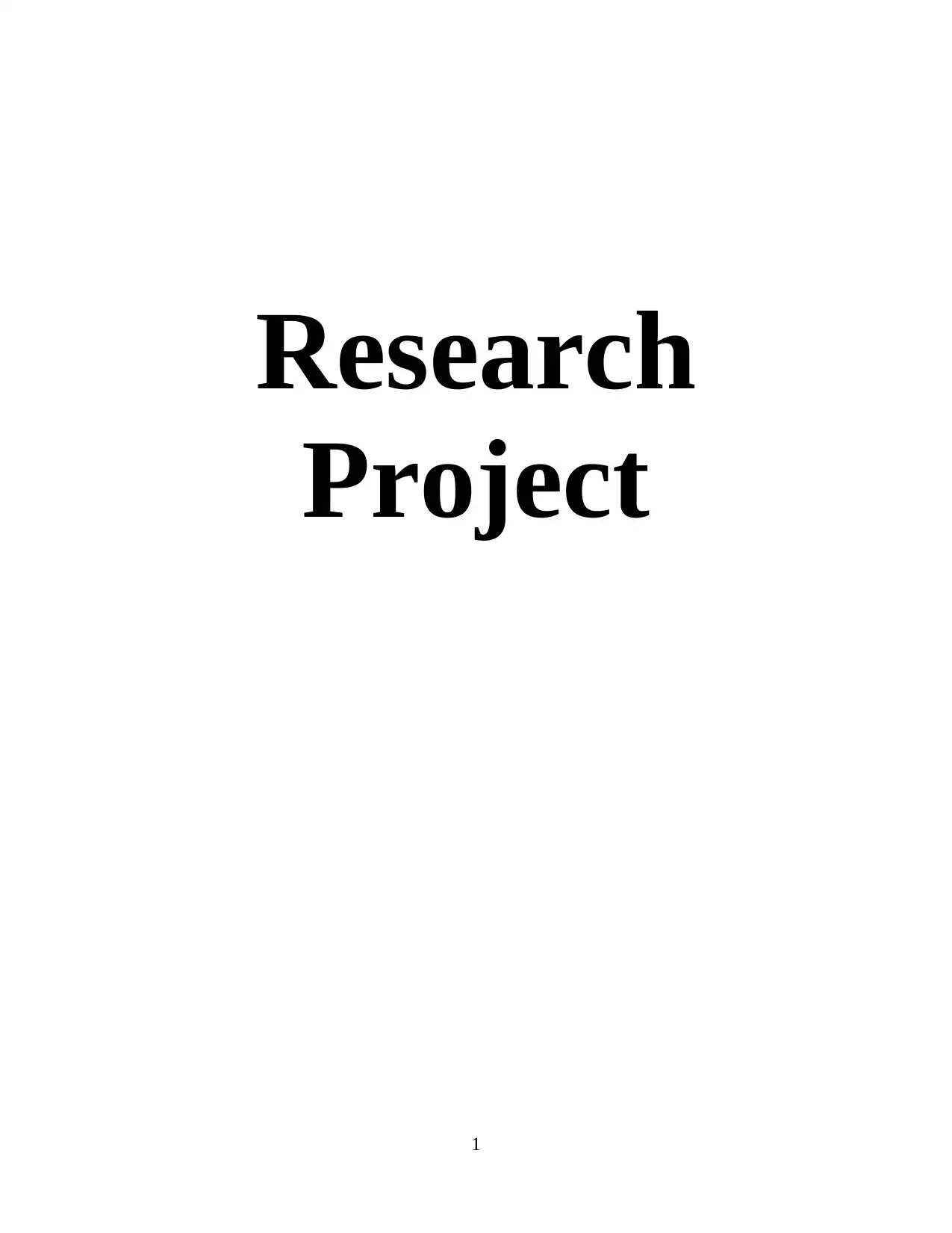
Research
Project
1
Project
1
Secure Best Marks with AI Grader
Need help grading? Try our AI Grader for instant feedback on your assignments.
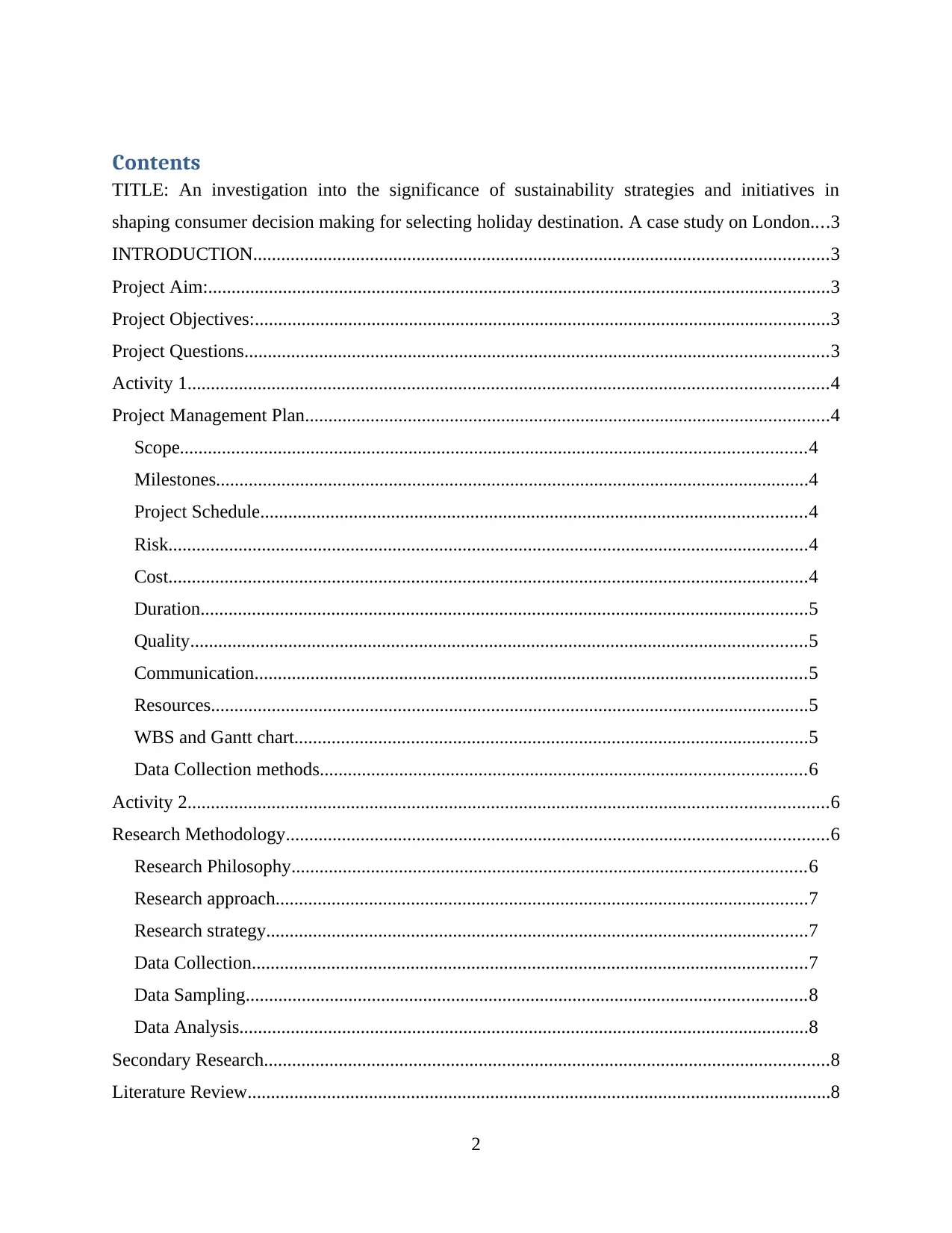
Contents
TITLE: An investigation into the significance of sustainability strategies and initiatives in
shaping consumer decision making for selecting holiday destination. A case study on London....3
INTRODUCTION...........................................................................................................................3
Project Aim:.....................................................................................................................................3
Project Objectives:...........................................................................................................................3
Project Questions.............................................................................................................................3
Activity 1.........................................................................................................................................4
Project Management Plan................................................................................................................4
Scope......................................................................................................................................4
Milestones...............................................................................................................................4
Project Schedule.....................................................................................................................4
Risk.........................................................................................................................................4
Cost.........................................................................................................................................4
Duration..................................................................................................................................5
Quality....................................................................................................................................5
Communication......................................................................................................................5
Resources................................................................................................................................5
WBS and Gantt chart..............................................................................................................5
Data Collection methods........................................................................................................6
Activity 2.........................................................................................................................................6
Research Methodology....................................................................................................................6
Research Philosophy..............................................................................................................6
Research approach..................................................................................................................7
Research strategy....................................................................................................................7
Data Collection.......................................................................................................................7
Data Sampling........................................................................................................................8
Data Analysis..........................................................................................................................8
Secondary Research.........................................................................................................................8
Literature Review.............................................................................................................................8
2
TITLE: An investigation into the significance of sustainability strategies and initiatives in
shaping consumer decision making for selecting holiday destination. A case study on London....3
INTRODUCTION...........................................................................................................................3
Project Aim:.....................................................................................................................................3
Project Objectives:...........................................................................................................................3
Project Questions.............................................................................................................................3
Activity 1.........................................................................................................................................4
Project Management Plan................................................................................................................4
Scope......................................................................................................................................4
Milestones...............................................................................................................................4
Project Schedule.....................................................................................................................4
Risk.........................................................................................................................................4
Cost.........................................................................................................................................4
Duration..................................................................................................................................5
Quality....................................................................................................................................5
Communication......................................................................................................................5
Resources................................................................................................................................5
WBS and Gantt chart..............................................................................................................5
Data Collection methods........................................................................................................6
Activity 2.........................................................................................................................................6
Research Methodology....................................................................................................................6
Research Philosophy..............................................................................................................6
Research approach..................................................................................................................7
Research strategy....................................................................................................................7
Data Collection.......................................................................................................................7
Data Sampling........................................................................................................................8
Data Analysis..........................................................................................................................8
Secondary Research.........................................................................................................................8
Literature Review.............................................................................................................................8
2
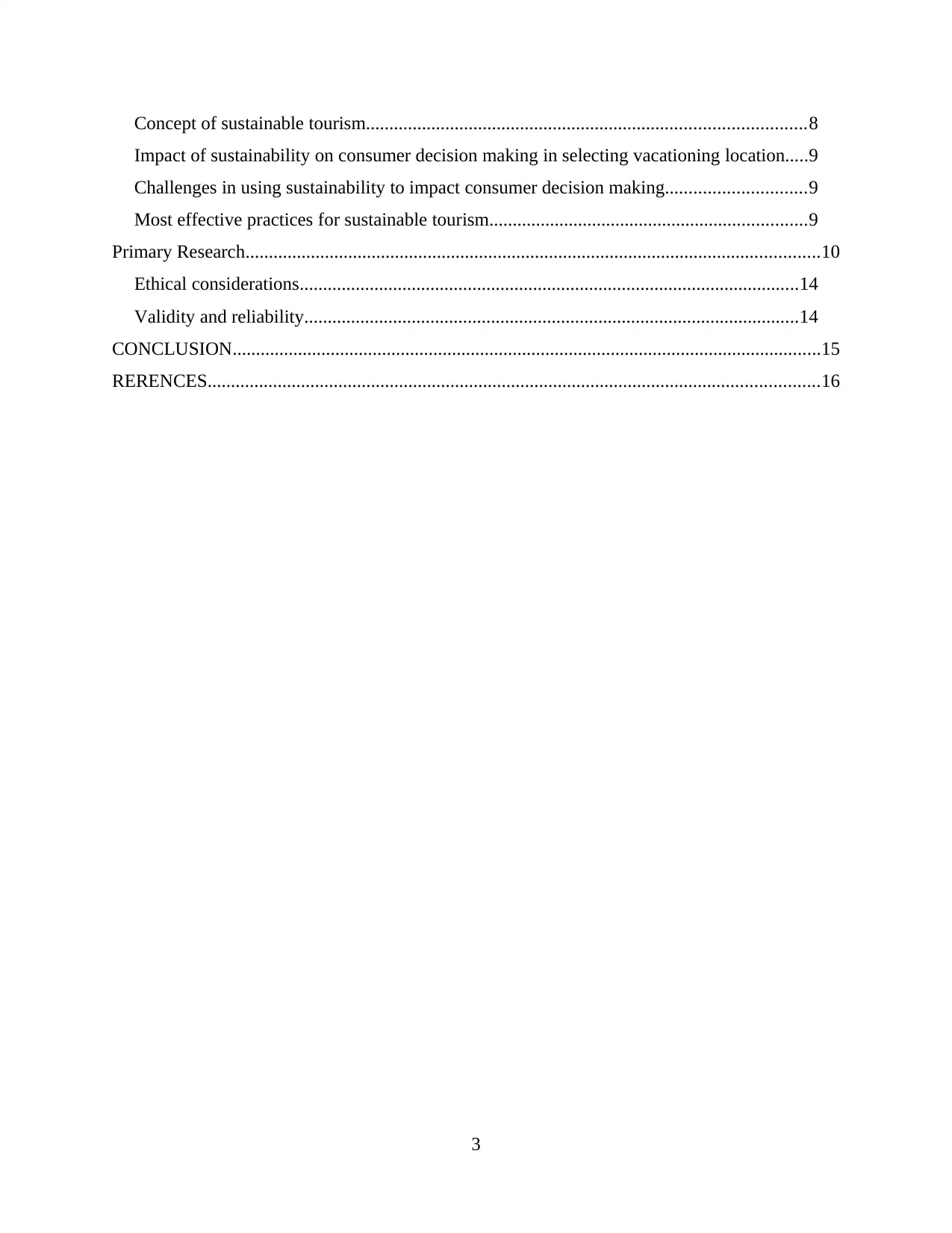
Concept of sustainable tourism..............................................................................................8
Impact of sustainability on consumer decision making in selecting vacationing location.....9
Challenges in using sustainability to impact consumer decision making..............................9
Most effective practices for sustainable tourism....................................................................9
Primary Research...........................................................................................................................10
Ethical considerations...........................................................................................................14
Validity and reliability..........................................................................................................14
CONCLUSION..............................................................................................................................15
RERENCES...................................................................................................................................16
3
Impact of sustainability on consumer decision making in selecting vacationing location.....9
Challenges in using sustainability to impact consumer decision making..............................9
Most effective practices for sustainable tourism....................................................................9
Primary Research...........................................................................................................................10
Ethical considerations...........................................................................................................14
Validity and reliability..........................................................................................................14
CONCLUSION..............................................................................................................................15
RERENCES...................................................................................................................................16
3
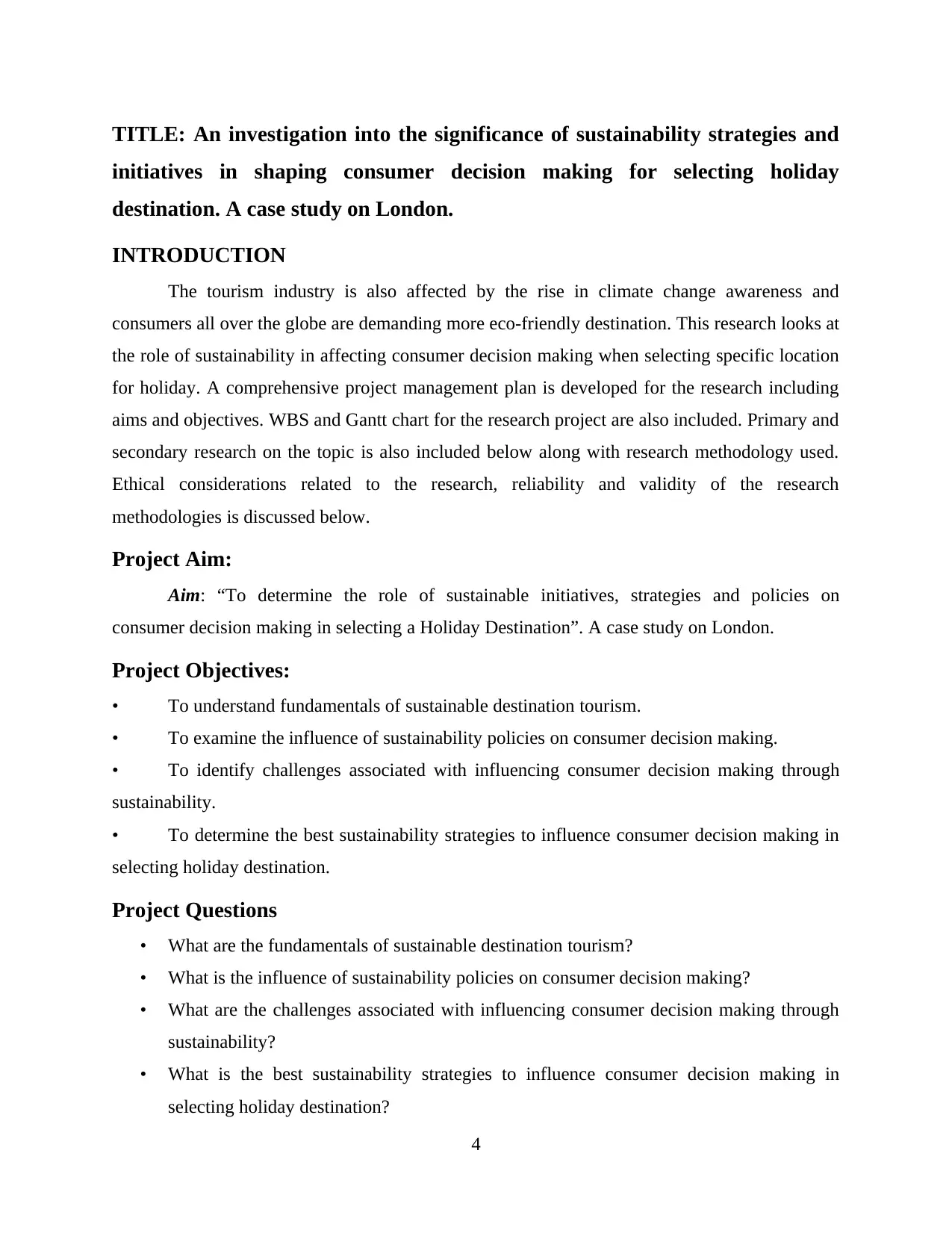
TITLE: An investigation into the significance of sustainability strategies and
initiatives in shaping consumer decision making for selecting holiday
destination. A case study on London.
INTRODUCTION
The tourism industry is also affected by the rise in climate change awareness and
consumers all over the globe are demanding more eco-friendly destination. This research looks at
the role of sustainability in affecting consumer decision making when selecting specific location
for holiday. A comprehensive project management plan is developed for the research including
aims and objectives. WBS and Gantt chart for the research project are also included. Primary and
secondary research on the topic is also included below along with research methodology used.
Ethical considerations related to the research, reliability and validity of the research
methodologies is discussed below.
Project Aim:
Aim: “To determine the role of sustainable initiatives, strategies and policies on
consumer decision making in selecting a Holiday Destination”. A case study on London.
Project Objectives:
• To understand fundamentals of sustainable destination tourism.
• To examine the influence of sustainability policies on consumer decision making.
• To identify challenges associated with influencing consumer decision making through
sustainability.
• To determine the best sustainability strategies to influence consumer decision making in
selecting holiday destination.
Project Questions
• What are the fundamentals of sustainable destination tourism?
• What is the influence of sustainability policies on consumer decision making?
• What are the challenges associated with influencing consumer decision making through
sustainability?
• What is the best sustainability strategies to influence consumer decision making in
selecting holiday destination?
4
initiatives in shaping consumer decision making for selecting holiday
destination. A case study on London.
INTRODUCTION
The tourism industry is also affected by the rise in climate change awareness and
consumers all over the globe are demanding more eco-friendly destination. This research looks at
the role of sustainability in affecting consumer decision making when selecting specific location
for holiday. A comprehensive project management plan is developed for the research including
aims and objectives. WBS and Gantt chart for the research project are also included. Primary and
secondary research on the topic is also included below along with research methodology used.
Ethical considerations related to the research, reliability and validity of the research
methodologies is discussed below.
Project Aim:
Aim: “To determine the role of sustainable initiatives, strategies and policies on
consumer decision making in selecting a Holiday Destination”. A case study on London.
Project Objectives:
• To understand fundamentals of sustainable destination tourism.
• To examine the influence of sustainability policies on consumer decision making.
• To identify challenges associated with influencing consumer decision making through
sustainability.
• To determine the best sustainability strategies to influence consumer decision making in
selecting holiday destination.
Project Questions
• What are the fundamentals of sustainable destination tourism?
• What is the influence of sustainability policies on consumer decision making?
• What are the challenges associated with influencing consumer decision making through
sustainability?
• What is the best sustainability strategies to influence consumer decision making in
selecting holiday destination?
4
Secure Best Marks with AI Grader
Need help grading? Try our AI Grader for instant feedback on your assignments.
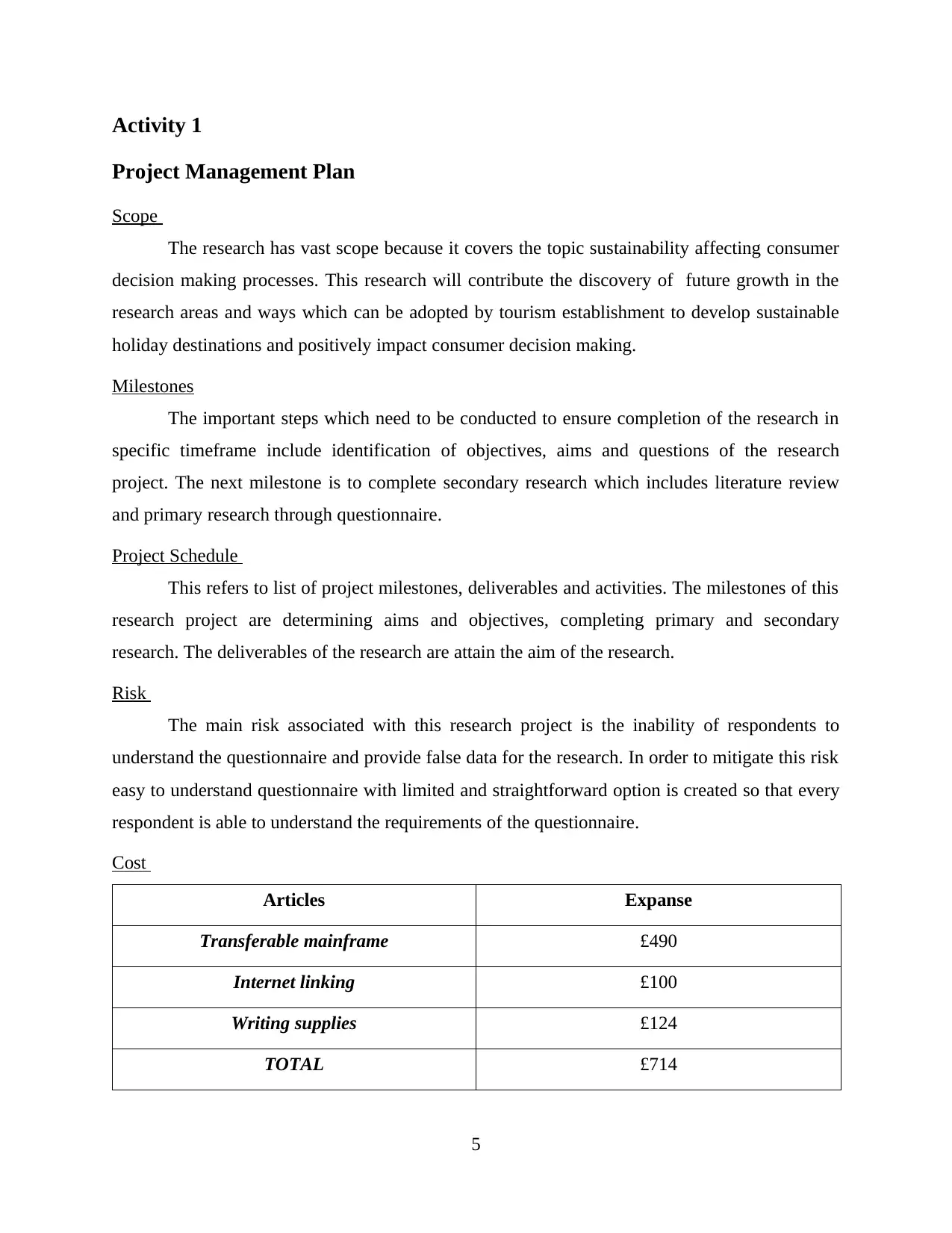
Activity 1
Project Management Plan
Scope
The research has vast scope because it covers the topic sustainability affecting consumer
decision making processes. This research will contribute the discovery of future growth in the
research areas and ways which can be adopted by tourism establishment to develop sustainable
holiday destinations and positively impact consumer decision making.
Milestones
The important steps which need to be conducted to ensure completion of the research in
specific timeframe include identification of objectives, aims and questions of the research
project. The next milestone is to complete secondary research which includes literature review
and primary research through questionnaire.
Project Schedule
This refers to list of project milestones, deliverables and activities. The milestones of this
research project are determining aims and objectives, completing primary and secondary
research. The deliverables of the research are attain the aim of the research.
Risk
The main risk associated with this research project is the inability of respondents to
understand the questionnaire and provide false data for the research. In order to mitigate this risk
easy to understand questionnaire with limited and straightforward option is created so that every
respondent is able to understand the requirements of the questionnaire.
Cost
Articles Expanse
Transferable mainframe £490
Internet linking £100
Writing supplies £124
TOTAL £714
5
Project Management Plan
Scope
The research has vast scope because it covers the topic sustainability affecting consumer
decision making processes. This research will contribute the discovery of future growth in the
research areas and ways which can be adopted by tourism establishment to develop sustainable
holiday destinations and positively impact consumer decision making.
Milestones
The important steps which need to be conducted to ensure completion of the research in
specific timeframe include identification of objectives, aims and questions of the research
project. The next milestone is to complete secondary research which includes literature review
and primary research through questionnaire.
Project Schedule
This refers to list of project milestones, deliverables and activities. The milestones of this
research project are determining aims and objectives, completing primary and secondary
research. The deliverables of the research are attain the aim of the research.
Risk
The main risk associated with this research project is the inability of respondents to
understand the questionnaire and provide false data for the research. In order to mitigate this risk
easy to understand questionnaire with limited and straightforward option is created so that every
respondent is able to understand the requirements of the questionnaire.
Cost
Articles Expanse
Transferable mainframe £490
Internet linking £100
Writing supplies £124
TOTAL £714
5
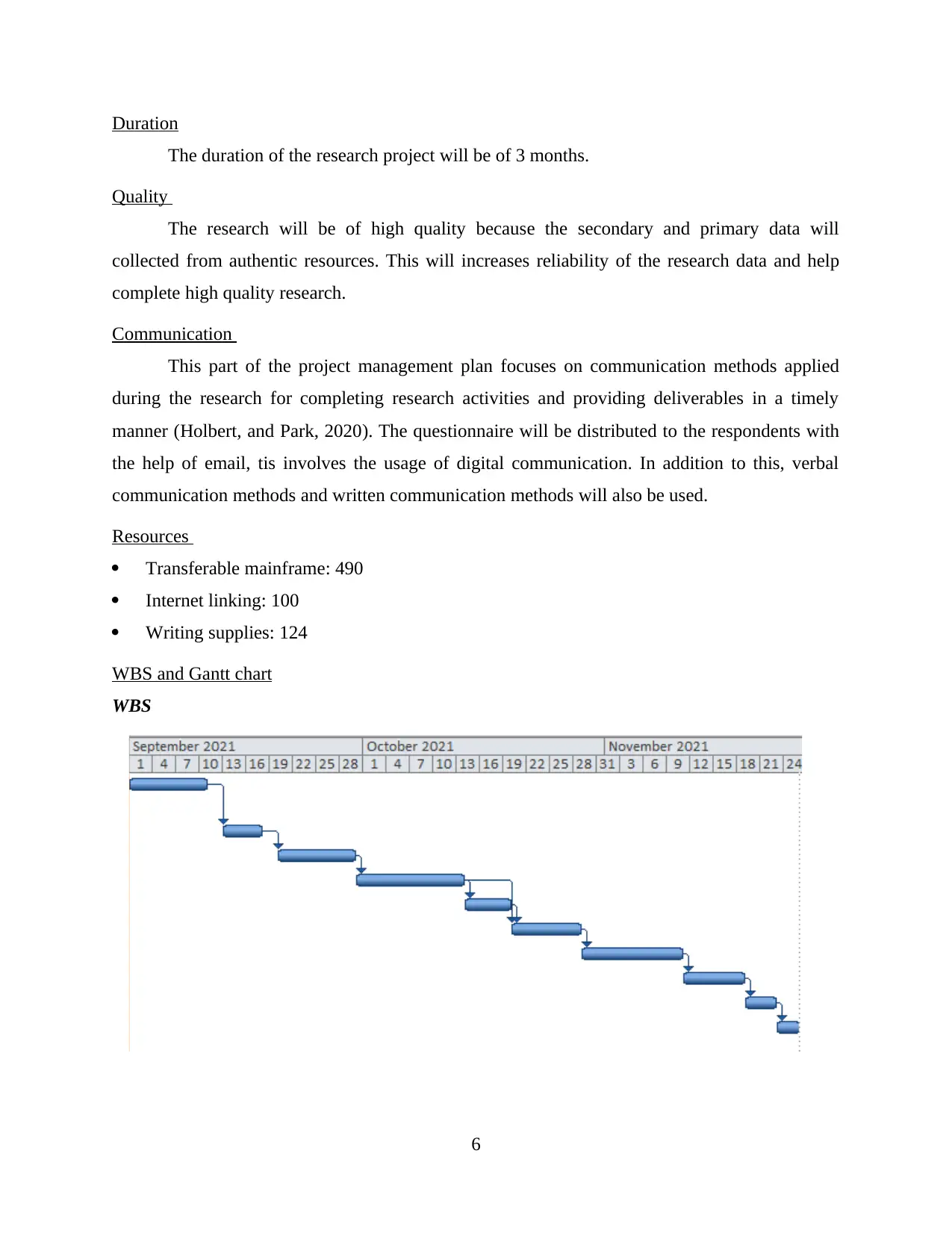
Duration
The duration of the research project will be of 3 months.
Quality
The research will be of high quality because the secondary and primary data will
collected from authentic resources. This will increases reliability of the research data and help
complete high quality research.
Communication
This part of the project management plan focuses on communication methods applied
during the research for completing research activities and providing deliverables in a timely
manner (Holbert, and Park, 2020). The questionnaire will be distributed to the respondents with
the help of email, tis involves the usage of digital communication. In addition to this, verbal
communication methods and written communication methods will also be used.
Resources
Transferable mainframe: 490
Internet linking: 100
Writing supplies: 124
WBS and Gantt chart
WBS
6
The duration of the research project will be of 3 months.
Quality
The research will be of high quality because the secondary and primary data will
collected from authentic resources. This will increases reliability of the research data and help
complete high quality research.
Communication
This part of the project management plan focuses on communication methods applied
during the research for completing research activities and providing deliverables in a timely
manner (Holbert, and Park, 2020). The questionnaire will be distributed to the respondents with
the help of email, tis involves the usage of digital communication. In addition to this, verbal
communication methods and written communication methods will also be used.
Resources
Transferable mainframe: 490
Internet linking: 100
Writing supplies: 124
WBS and Gantt chart
WBS
6
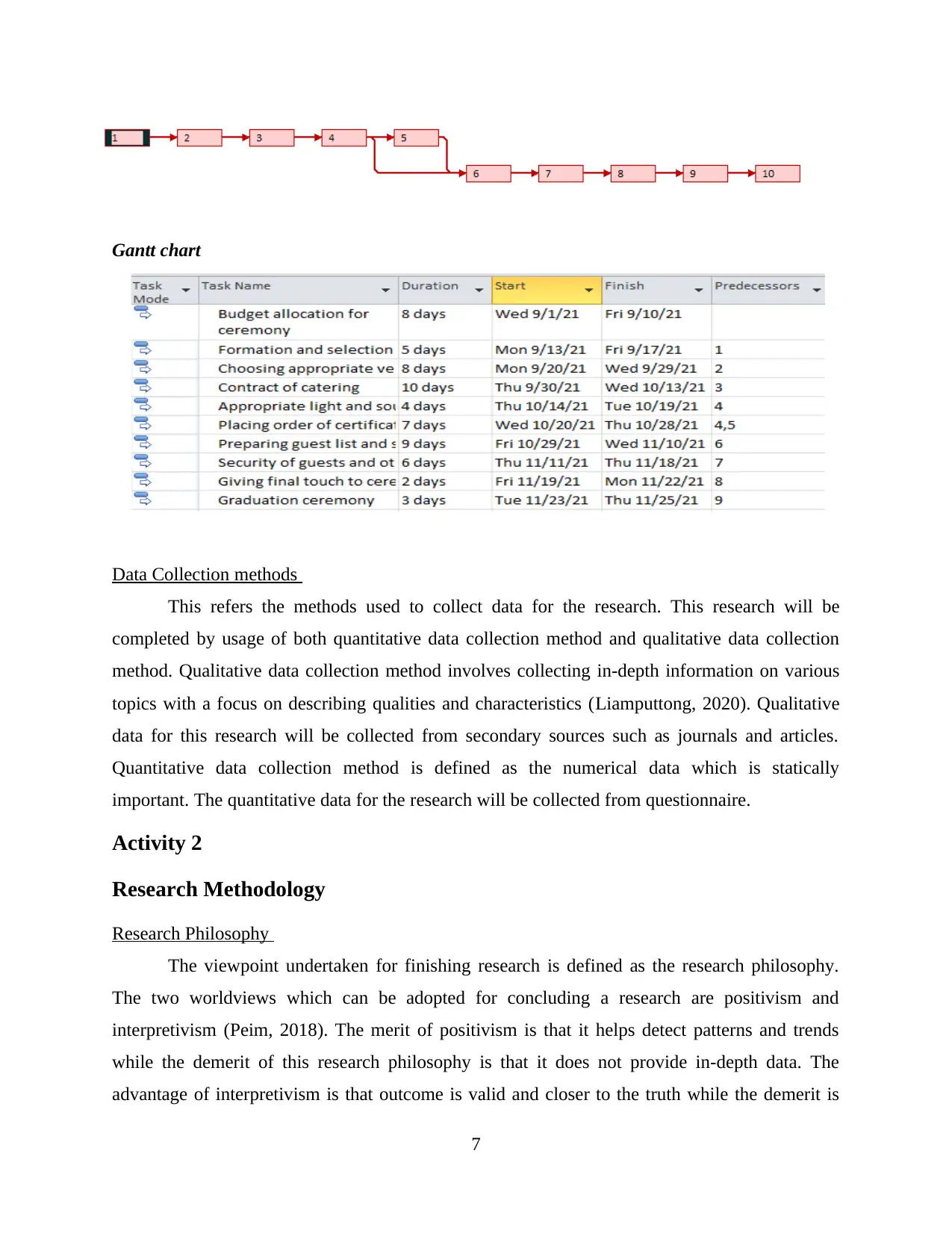
Gantt chart
Data Collection methods
This refers the methods used to collect data for the research. This research will be
completed by usage of both quantitative data collection method and qualitative data collection
method. Qualitative data collection method involves collecting in-depth information on various
topics with a focus on describing qualities and characteristics (Liamputtong, 2020). Qualitative
data for this research will be collected from secondary sources such as journals and articles.
Quantitative data collection method is defined as the numerical data which is statically
important. The quantitative data for the research will be collected from questionnaire.
Activity 2
Research Methodology
Research Philosophy
The viewpoint undertaken for finishing research is defined as the research philosophy.
The two worldviews which can be adopted for concluding a research are positivism and
interpretivism (Peim, 2018). The merit of positivism is that it helps detect patterns and trends
while the demerit of this research philosophy is that it does not provide in-depth data. The
advantage of interpretivism is that outcome is valid and closer to the truth while the demerit is
7
Data Collection methods
This refers the methods used to collect data for the research. This research will be
completed by usage of both quantitative data collection method and qualitative data collection
method. Qualitative data collection method involves collecting in-depth information on various
topics with a focus on describing qualities and characteristics (Liamputtong, 2020). Qualitative
data for this research will be collected from secondary sources such as journals and articles.
Quantitative data collection method is defined as the numerical data which is statically
important. The quantitative data for the research will be collected from questionnaire.
Activity 2
Research Methodology
Research Philosophy
The viewpoint undertaken for finishing research is defined as the research philosophy.
The two worldviews which can be adopted for concluding a research are positivism and
interpretivism (Peim, 2018). The merit of positivism is that it helps detect patterns and trends
while the demerit of this research philosophy is that it does not provide in-depth data. The
advantage of interpretivism is that outcome is valid and closer to the truth while the demerit is
7
Paraphrase This Document
Need a fresh take? Get an instant paraphrase of this document with our AI Paraphraser
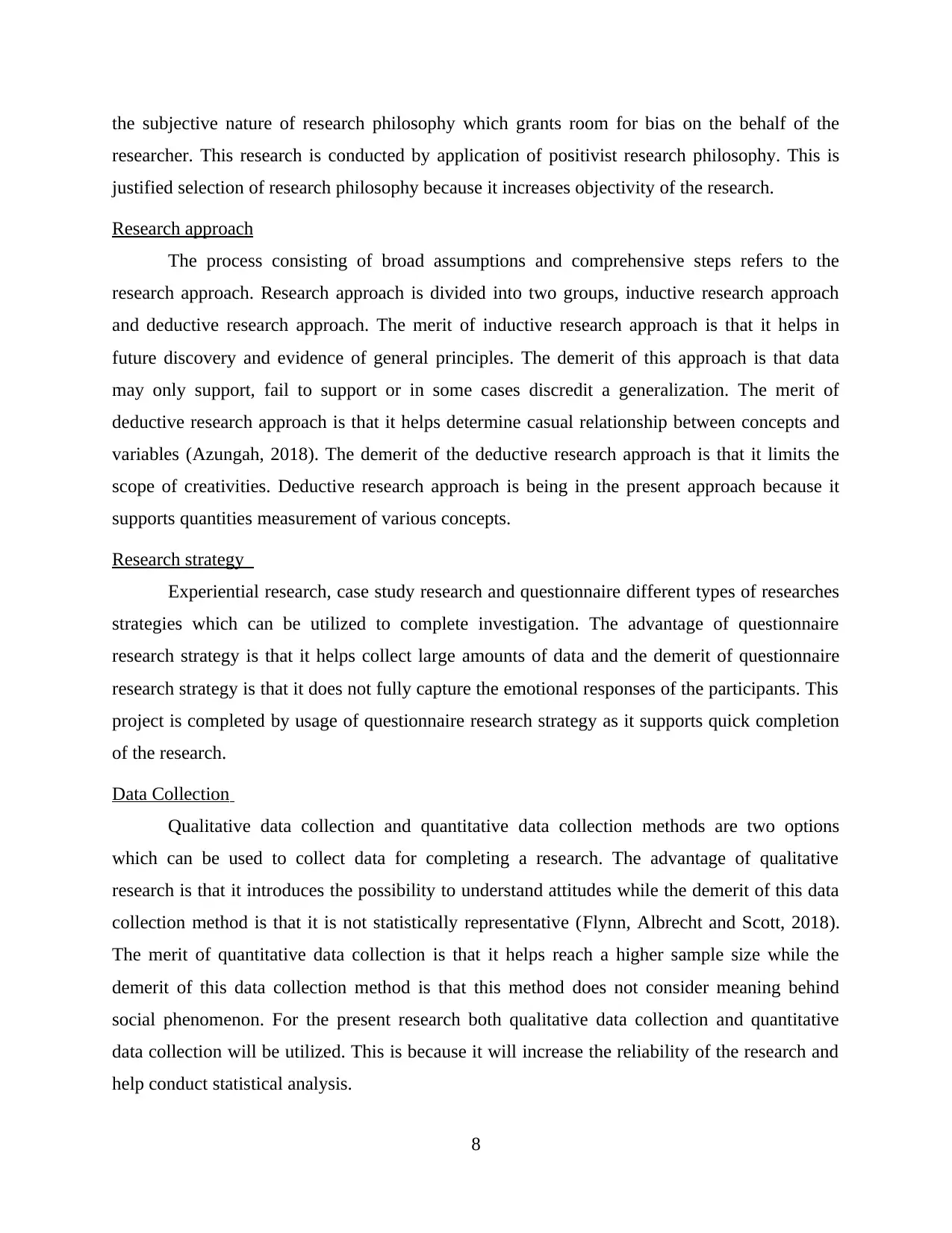
the subjective nature of research philosophy which grants room for bias on the behalf of the
researcher. This research is conducted by application of positivist research philosophy. This is
justified selection of research philosophy because it increases objectivity of the research.
Research approach
The process consisting of broad assumptions and comprehensive steps refers to the
research approach. Research approach is divided into two groups, inductive research approach
and deductive research approach. The merit of inductive research approach is that it helps in
future discovery and evidence of general principles. The demerit of this approach is that data
may only support, fail to support or in some cases discredit a generalization. The merit of
deductive research approach is that it helps determine casual relationship between concepts and
variables (Azungah, 2018). The demerit of the deductive research approach is that it limits the
scope of creativities. Deductive research approach is being in the present approach because it
supports quantities measurement of various concepts.
Research strategy
Experiential research, case study research and questionnaire different types of researches
strategies which can be utilized to complete investigation. The advantage of questionnaire
research strategy is that it helps collect large amounts of data and the demerit of questionnaire
research strategy is that it does not fully capture the emotional responses of the participants. This
project is completed by usage of questionnaire research strategy as it supports quick completion
of the research.
Data Collection
Qualitative data collection and quantitative data collection methods are two options
which can be used to collect data for completing a research. The advantage of qualitative
research is that it introduces the possibility to understand attitudes while the demerit of this data
collection method is that it is not statistically representative (Flynn, Albrecht and Scott, 2018).
The merit of quantitative data collection is that it helps reach a higher sample size while the
demerit of this data collection method is that this method does not consider meaning behind
social phenomenon. For the present research both qualitative data collection and quantitative
data collection will be utilized. This is because it will increase the reliability of the research and
help conduct statistical analysis.
8
researcher. This research is conducted by application of positivist research philosophy. This is
justified selection of research philosophy because it increases objectivity of the research.
Research approach
The process consisting of broad assumptions and comprehensive steps refers to the
research approach. Research approach is divided into two groups, inductive research approach
and deductive research approach. The merit of inductive research approach is that it helps in
future discovery and evidence of general principles. The demerit of this approach is that data
may only support, fail to support or in some cases discredit a generalization. The merit of
deductive research approach is that it helps determine casual relationship between concepts and
variables (Azungah, 2018). The demerit of the deductive research approach is that it limits the
scope of creativities. Deductive research approach is being in the present approach because it
supports quantities measurement of various concepts.
Research strategy
Experiential research, case study research and questionnaire different types of researches
strategies which can be utilized to complete investigation. The advantage of questionnaire
research strategy is that it helps collect large amounts of data and the demerit of questionnaire
research strategy is that it does not fully capture the emotional responses of the participants. This
project is completed by usage of questionnaire research strategy as it supports quick completion
of the research.
Data Collection
Qualitative data collection and quantitative data collection methods are two options
which can be used to collect data for completing a research. The advantage of qualitative
research is that it introduces the possibility to understand attitudes while the demerit of this data
collection method is that it is not statistically representative (Flynn, Albrecht and Scott, 2018).
The merit of quantitative data collection is that it helps reach a higher sample size while the
demerit of this data collection method is that this method does not consider meaning behind
social phenomenon. For the present research both qualitative data collection and quantitative
data collection will be utilized. This is because it will increase the reliability of the research and
help conduct statistical analysis.
8
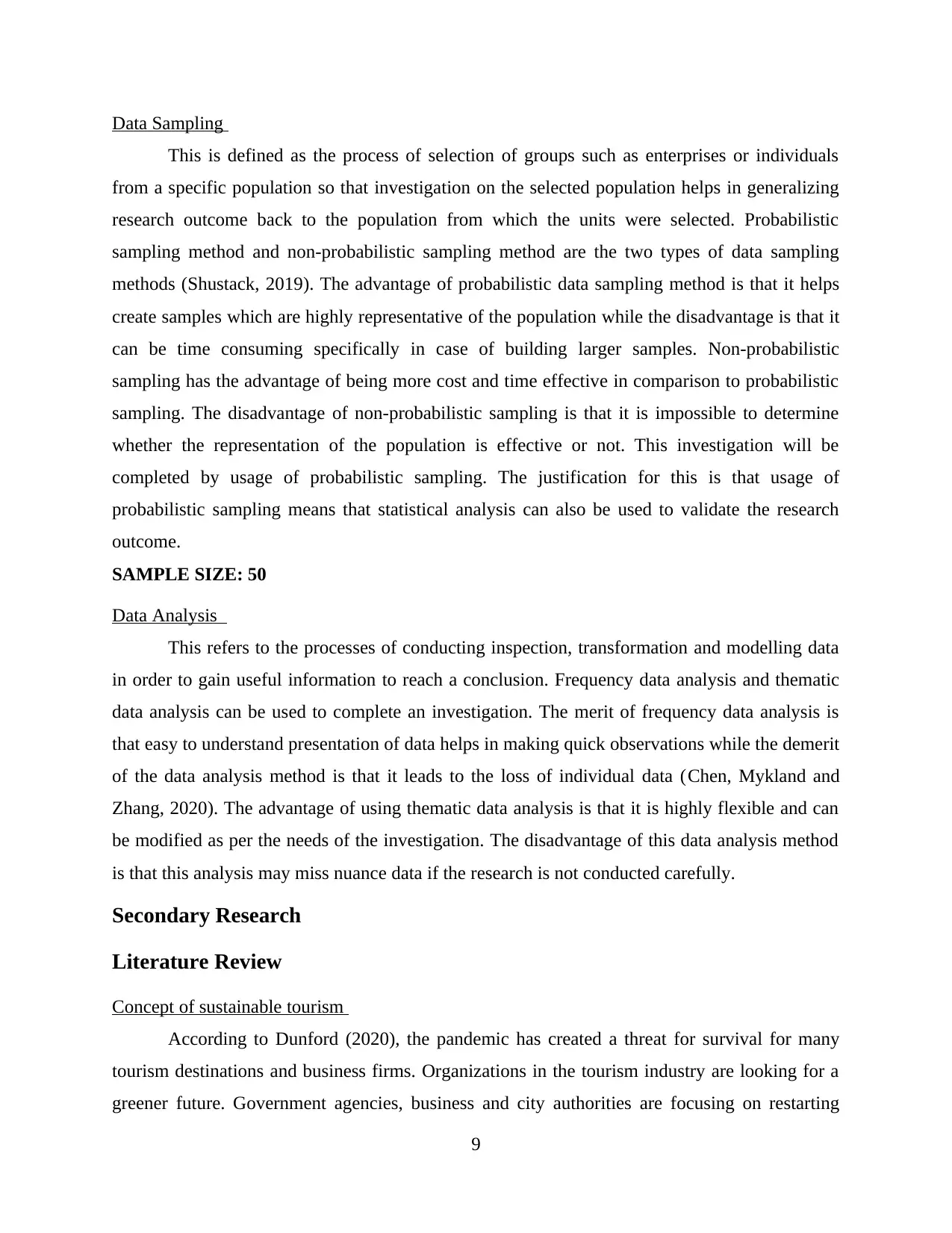
Data Sampling
This is defined as the process of selection of groups such as enterprises or individuals
from a specific population so that investigation on the selected population helps in generalizing
research outcome back to the population from which the units were selected. Probabilistic
sampling method and non-probabilistic sampling method are the two types of data sampling
methods (Shustack, 2019). The advantage of probabilistic data sampling method is that it helps
create samples which are highly representative of the population while the disadvantage is that it
can be time consuming specifically in case of building larger samples. Non-probabilistic
sampling has the advantage of being more cost and time effective in comparison to probabilistic
sampling. The disadvantage of non-probabilistic sampling is that it is impossible to determine
whether the representation of the population is effective or not. This investigation will be
completed by usage of probabilistic sampling. The justification for this is that usage of
probabilistic sampling means that statistical analysis can also be used to validate the research
outcome.
SAMPLE SIZE: 50
Data Analysis
This refers to the processes of conducting inspection, transformation and modelling data
in order to gain useful information to reach a conclusion. Frequency data analysis and thematic
data analysis can be used to complete an investigation. The merit of frequency data analysis is
that easy to understand presentation of data helps in making quick observations while the demerit
of the data analysis method is that it leads to the loss of individual data (Chen, Mykland and
Zhang, 2020). The advantage of using thematic data analysis is that it is highly flexible and can
be modified as per the needs of the investigation. The disadvantage of this data analysis method
is that this analysis may miss nuance data if the research is not conducted carefully.
Secondary Research
Literature Review
Concept of sustainable tourism
According to Dunford (2020), the pandemic has created a threat for survival for many
tourism destinations and business firms. Organizations in the tourism industry are looking for a
greener future. Government agencies, business and city authorities are focusing on restarting
9
This is defined as the process of selection of groups such as enterprises or individuals
from a specific population so that investigation on the selected population helps in generalizing
research outcome back to the population from which the units were selected. Probabilistic
sampling method and non-probabilistic sampling method are the two types of data sampling
methods (Shustack, 2019). The advantage of probabilistic data sampling method is that it helps
create samples which are highly representative of the population while the disadvantage is that it
can be time consuming specifically in case of building larger samples. Non-probabilistic
sampling has the advantage of being more cost and time effective in comparison to probabilistic
sampling. The disadvantage of non-probabilistic sampling is that it is impossible to determine
whether the representation of the population is effective or not. This investigation will be
completed by usage of probabilistic sampling. The justification for this is that usage of
probabilistic sampling means that statistical analysis can also be used to validate the research
outcome.
SAMPLE SIZE: 50
Data Analysis
This refers to the processes of conducting inspection, transformation and modelling data
in order to gain useful information to reach a conclusion. Frequency data analysis and thematic
data analysis can be used to complete an investigation. The merit of frequency data analysis is
that easy to understand presentation of data helps in making quick observations while the demerit
of the data analysis method is that it leads to the loss of individual data (Chen, Mykland and
Zhang, 2020). The advantage of using thematic data analysis is that it is highly flexible and can
be modified as per the needs of the investigation. The disadvantage of this data analysis method
is that this analysis may miss nuance data if the research is not conducted carefully.
Secondary Research
Literature Review
Concept of sustainable tourism
According to Dunford (2020), the pandemic has created a threat for survival for many
tourism destinations and business firms. Organizations in the tourism industry are looking for a
greener future. Government agencies, business and city authorities are focusing on restarting
9
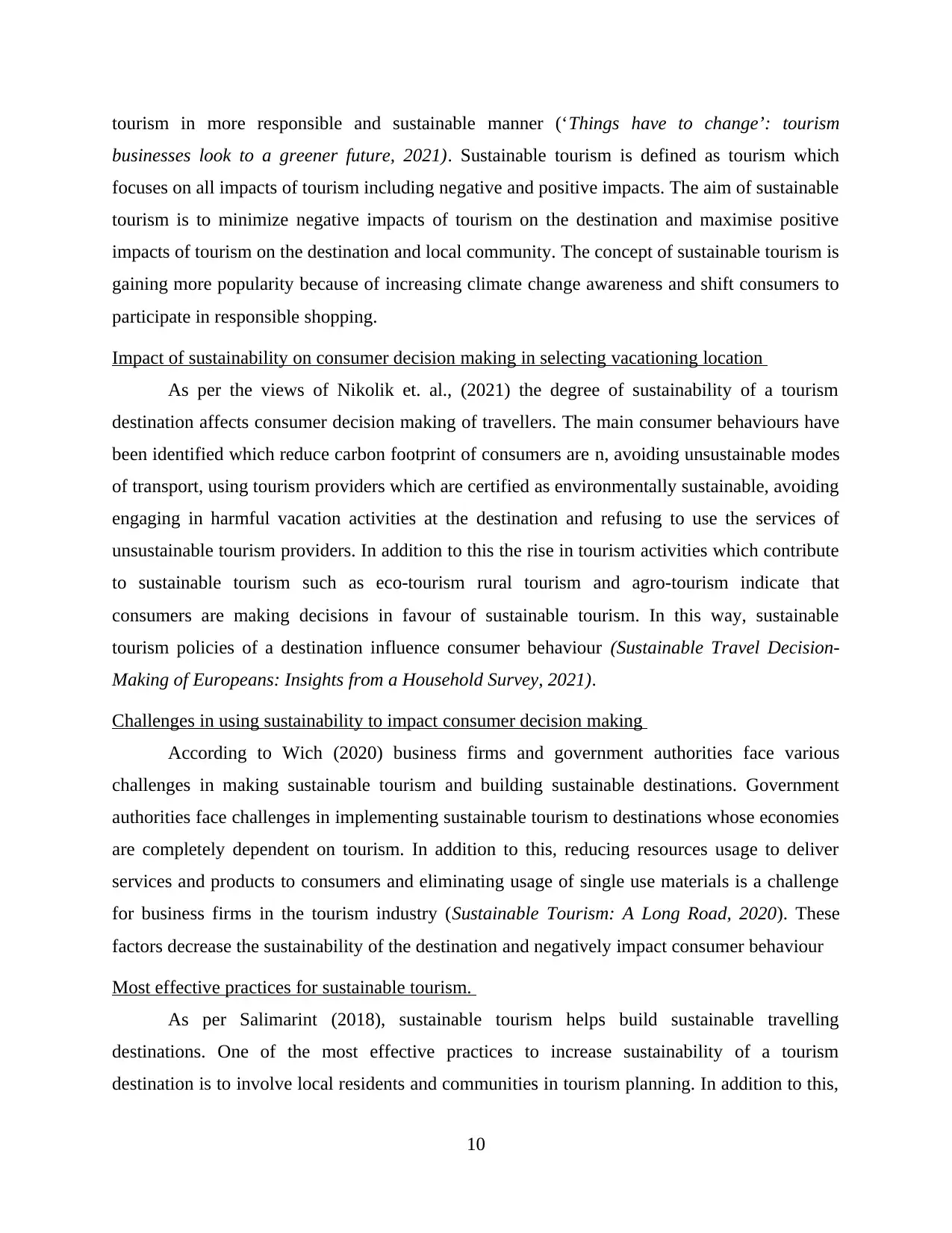
tourism in more responsible and sustainable manner (‘Things have to change’: tourism
businesses look to a greener future, 2021). Sustainable tourism is defined as tourism which
focuses on all impacts of tourism including negative and positive impacts. The aim of sustainable
tourism is to minimize negative impacts of tourism on the destination and maximise positive
impacts of tourism on the destination and local community. The concept of sustainable tourism is
gaining more popularity because of increasing climate change awareness and shift consumers to
participate in responsible shopping.
Impact of sustainability on consumer decision making in selecting vacationing location
As per the views of Nikolik et. al., (2021) the degree of sustainability of a tourism
destination affects consumer decision making of travellers. The main consumer behaviours have
been identified which reduce carbon footprint of consumers are n, avoiding unsustainable modes
of transport, using tourism providers which are certified as environmentally sustainable, avoiding
engaging in harmful vacation activities at the destination and refusing to use the services of
unsustainable tourism providers. In addition to this the rise in tourism activities which contribute
to sustainable tourism such as eco-tourism rural tourism and agro-tourism indicate that
consumers are making decisions in favour of sustainable tourism. In this way, sustainable
tourism policies of a destination influence consumer behaviour (Sustainable Travel Decision-
Making of Europeans: Insights from a Household Survey, 2021).
Challenges in using sustainability to impact consumer decision making
According to Wich (2020) business firms and government authorities face various
challenges in making sustainable tourism and building sustainable destinations. Government
authorities face challenges in implementing sustainable tourism to destinations whose economies
are completely dependent on tourism. In addition to this, reducing resources usage to deliver
services and products to consumers and eliminating usage of single use materials is a challenge
for business firms in the tourism industry (Sustainable Tourism: A Long Road, 2020). These
factors decrease the sustainability of the destination and negatively impact consumer behaviour
Most effective practices for sustainable tourism.
As per Salimarint (2018), sustainable tourism helps build sustainable travelling
destinations. One of the most effective practices to increase sustainability of a tourism
destination is to involve local residents and communities in tourism planning. In addition to this,
10
businesses look to a greener future, 2021). Sustainable tourism is defined as tourism which
focuses on all impacts of tourism including negative and positive impacts. The aim of sustainable
tourism is to minimize negative impacts of tourism on the destination and maximise positive
impacts of tourism on the destination and local community. The concept of sustainable tourism is
gaining more popularity because of increasing climate change awareness and shift consumers to
participate in responsible shopping.
Impact of sustainability on consumer decision making in selecting vacationing location
As per the views of Nikolik et. al., (2021) the degree of sustainability of a tourism
destination affects consumer decision making of travellers. The main consumer behaviours have
been identified which reduce carbon footprint of consumers are n, avoiding unsustainable modes
of transport, using tourism providers which are certified as environmentally sustainable, avoiding
engaging in harmful vacation activities at the destination and refusing to use the services of
unsustainable tourism providers. In addition to this the rise in tourism activities which contribute
to sustainable tourism such as eco-tourism rural tourism and agro-tourism indicate that
consumers are making decisions in favour of sustainable tourism. In this way, sustainable
tourism policies of a destination influence consumer behaviour (Sustainable Travel Decision-
Making of Europeans: Insights from a Household Survey, 2021).
Challenges in using sustainability to impact consumer decision making
According to Wich (2020) business firms and government authorities face various
challenges in making sustainable tourism and building sustainable destinations. Government
authorities face challenges in implementing sustainable tourism to destinations whose economies
are completely dependent on tourism. In addition to this, reducing resources usage to deliver
services and products to consumers and eliminating usage of single use materials is a challenge
for business firms in the tourism industry (Sustainable Tourism: A Long Road, 2020). These
factors decrease the sustainability of the destination and negatively impact consumer behaviour
Most effective practices for sustainable tourism.
As per Salimarint (2018), sustainable tourism helps build sustainable travelling
destinations. One of the most effective practices to increase sustainability of a tourism
destination is to involve local residents and communities in tourism planning. In addition to this,
10
Secure Best Marks with AI Grader
Need help grading? Try our AI Grader for instant feedback on your assignments.
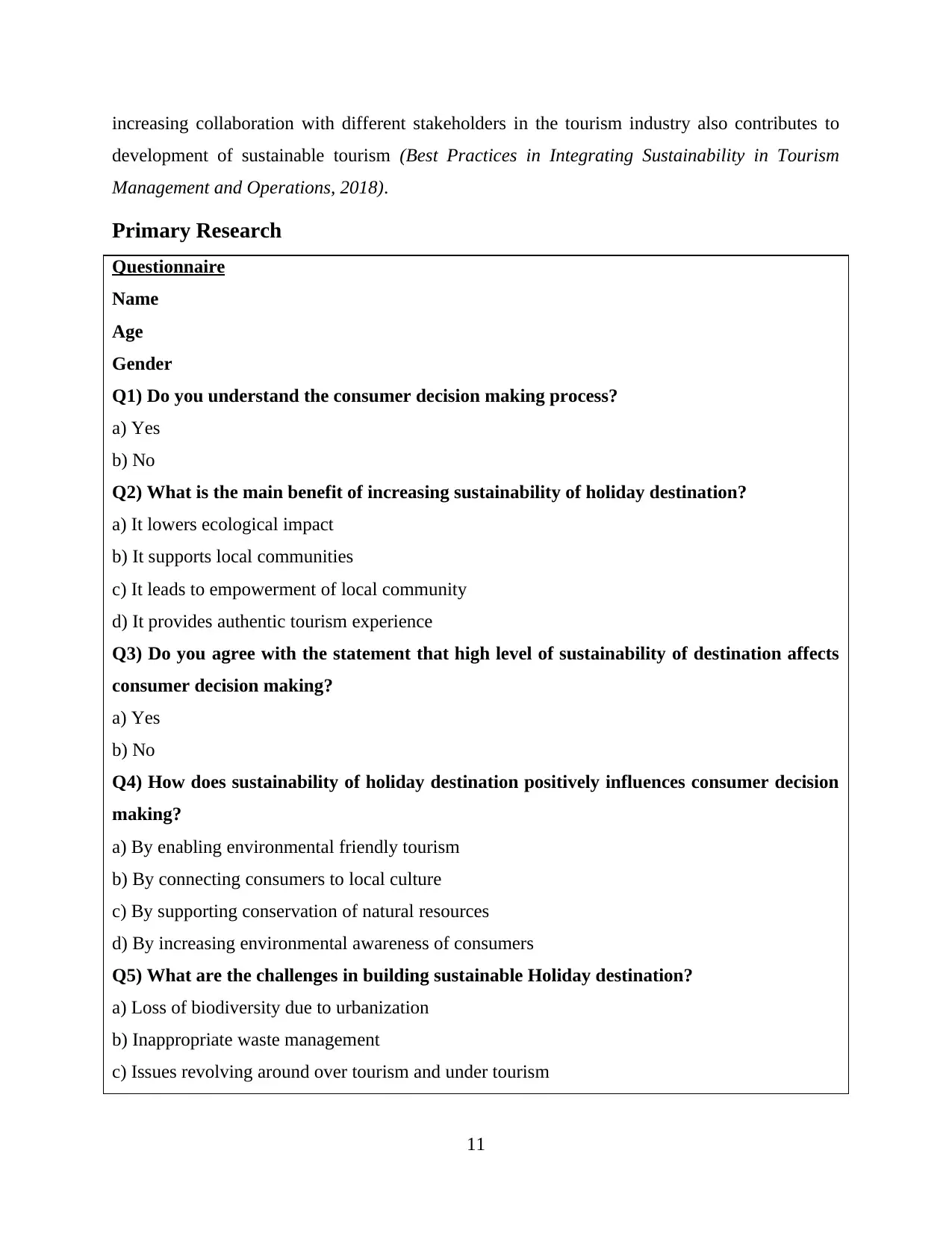
increasing collaboration with different stakeholders in the tourism industry also contributes to
development of sustainable tourism (Best Practices in Integrating Sustainability in Tourism
Management and Operations, 2018).
Primary Research
Questionnaire
Name
Age
Gender
Q1) Do you understand the consumer decision making process?
a) Yes
b) No
Q2) What is the main benefit of increasing sustainability of holiday destination?
a) It lowers ecological impact
b) It supports local communities
c) It leads to empowerment of local community
d) It provides authentic tourism experience
Q3) Do you agree with the statement that high level of sustainability of destination affects
consumer decision making?
a) Yes
b) No
Q4) How does sustainability of holiday destination positively influences consumer decision
making?
a) By enabling environmental friendly tourism
b) By connecting consumers to local culture
c) By supporting conservation of natural resources
d) By increasing environmental awareness of consumers
Q5) What are the challenges in building sustainable Holiday destination?
a) Loss of biodiversity due to urbanization
b) Inappropriate waste management
c) Issues revolving around over tourism and under tourism
11
development of sustainable tourism (Best Practices in Integrating Sustainability in Tourism
Management and Operations, 2018).
Primary Research
Questionnaire
Name
Age
Gender
Q1) Do you understand the consumer decision making process?
a) Yes
b) No
Q2) What is the main benefit of increasing sustainability of holiday destination?
a) It lowers ecological impact
b) It supports local communities
c) It leads to empowerment of local community
d) It provides authentic tourism experience
Q3) Do you agree with the statement that high level of sustainability of destination affects
consumer decision making?
a) Yes
b) No
Q4) How does sustainability of holiday destination positively influences consumer decision
making?
a) By enabling environmental friendly tourism
b) By connecting consumers to local culture
c) By supporting conservation of natural resources
d) By increasing environmental awareness of consumers
Q5) What are the challenges in building sustainable Holiday destination?
a) Loss of biodiversity due to urbanization
b) Inappropriate waste management
c) Issues revolving around over tourism and under tourism
11
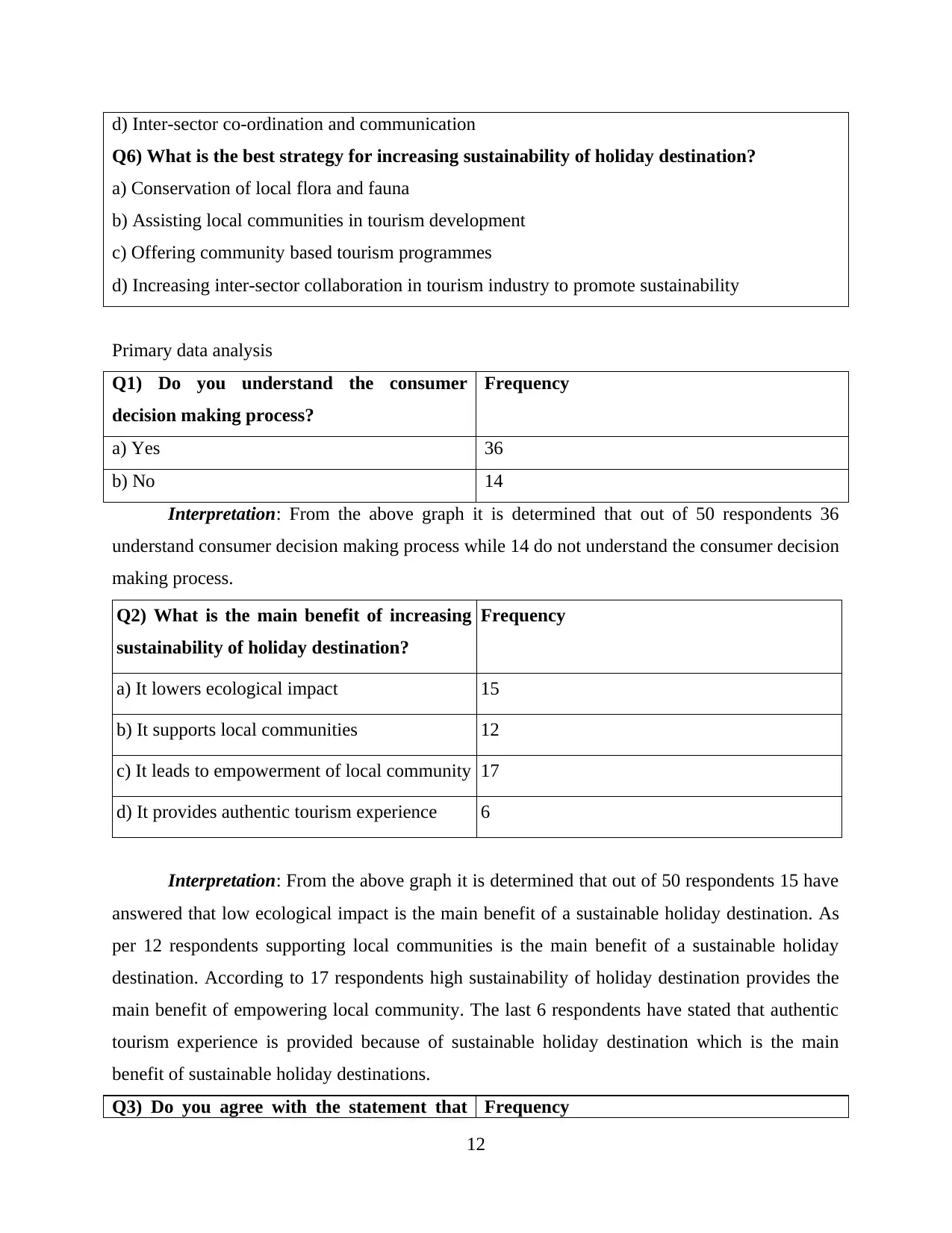
d) Inter-sector co-ordination and communication
Q6) What is the best strategy for increasing sustainability of holiday destination?
a) Conservation of local flora and fauna
b) Assisting local communities in tourism development
c) Offering community based tourism programmes
d) Increasing inter-sector collaboration in tourism industry to promote sustainability
Primary data analysis
Q1) Do you understand the consumer
decision making process?
Frequency
a) Yes 36
b) No 14
Interpretation: From the above graph it is determined that out of 50 respondents 36
understand consumer decision making process while 14 do not understand the consumer decision
making process.
Q2) What is the main benefit of increasing
sustainability of holiday destination?
Frequency
a) It lowers ecological impact 15
b) It supports local communities 12
c) It leads to empowerment of local community 17
d) It provides authentic tourism experience 6
Interpretation: From the above graph it is determined that out of 50 respondents 15 have
answered that low ecological impact is the main benefit of a sustainable holiday destination. As
per 12 respondents supporting local communities is the main benefit of a sustainable holiday
destination. According to 17 respondents high sustainability of holiday destination provides the
main benefit of empowering local community. The last 6 respondents have stated that authentic
tourism experience is provided because of sustainable holiday destination which is the main
benefit of sustainable holiday destinations.
Q3) Do you agree with the statement that Frequency
12
Q6) What is the best strategy for increasing sustainability of holiday destination?
a) Conservation of local flora and fauna
b) Assisting local communities in tourism development
c) Offering community based tourism programmes
d) Increasing inter-sector collaboration in tourism industry to promote sustainability
Primary data analysis
Q1) Do you understand the consumer
decision making process?
Frequency
a) Yes 36
b) No 14
Interpretation: From the above graph it is determined that out of 50 respondents 36
understand consumer decision making process while 14 do not understand the consumer decision
making process.
Q2) What is the main benefit of increasing
sustainability of holiday destination?
Frequency
a) It lowers ecological impact 15
b) It supports local communities 12
c) It leads to empowerment of local community 17
d) It provides authentic tourism experience 6
Interpretation: From the above graph it is determined that out of 50 respondents 15 have
answered that low ecological impact is the main benefit of a sustainable holiday destination. As
per 12 respondents supporting local communities is the main benefit of a sustainable holiday
destination. According to 17 respondents high sustainability of holiday destination provides the
main benefit of empowering local community. The last 6 respondents have stated that authentic
tourism experience is provided because of sustainable holiday destination which is the main
benefit of sustainable holiday destinations.
Q3) Do you agree with the statement that Frequency
12
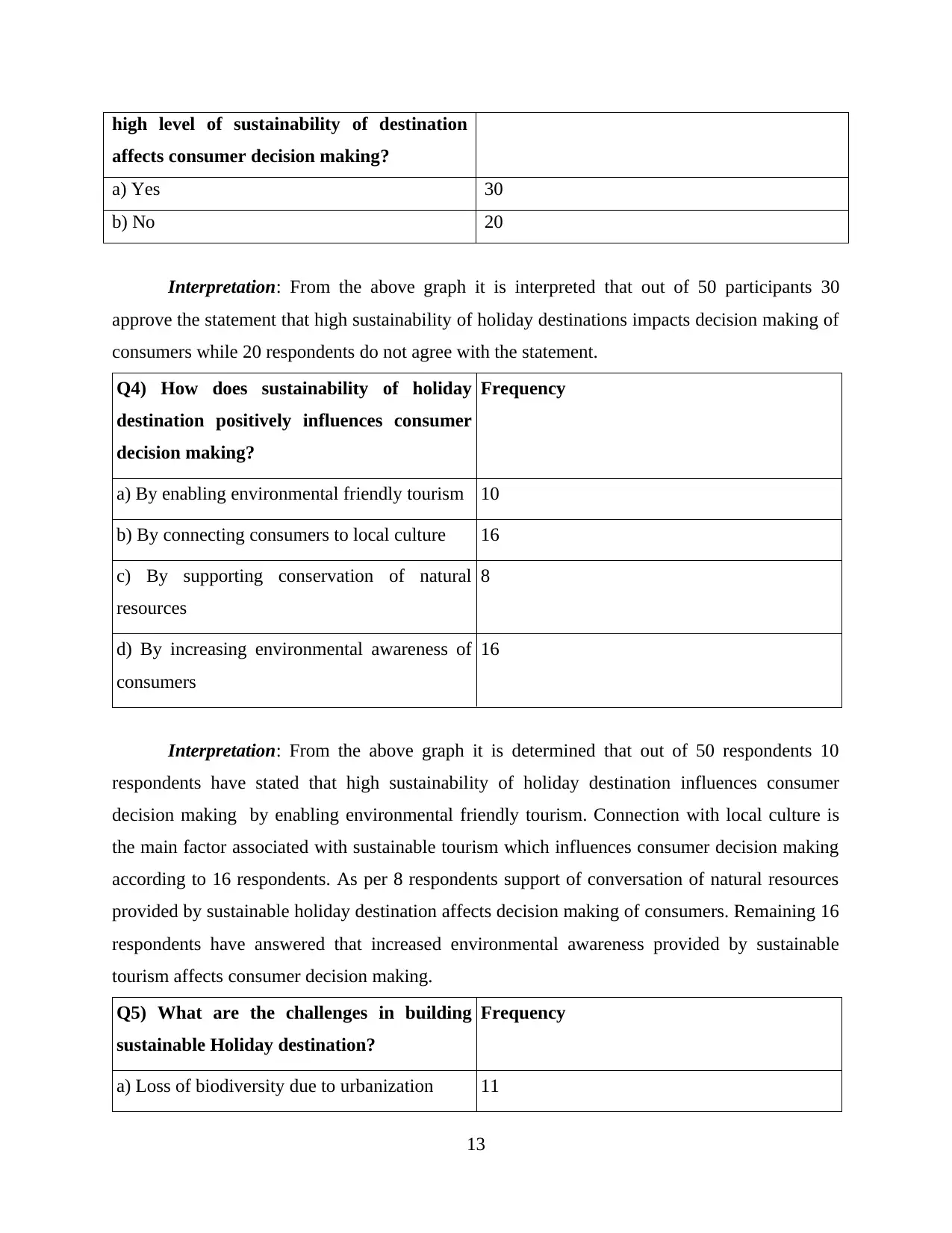
high level of sustainability of destination
affects consumer decision making?
a) Yes 30
b) No 20
Interpretation: From the above graph it is interpreted that out of 50 participants 30
approve the statement that high sustainability of holiday destinations impacts decision making of
consumers while 20 respondents do not agree with the statement.
Q4) How does sustainability of holiday
destination positively influences consumer
decision making?
Frequency
a) By enabling environmental friendly tourism 10
b) By connecting consumers to local culture 16
c) By supporting conservation of natural
resources
8
d) By increasing environmental awareness of
consumers
16
Interpretation: From the above graph it is determined that out of 50 respondents 10
respondents have stated that high sustainability of holiday destination influences consumer
decision making by enabling environmental friendly tourism. Connection with local culture is
the main factor associated with sustainable tourism which influences consumer decision making
according to 16 respondents. As per 8 respondents support of conversation of natural resources
provided by sustainable holiday destination affects decision making of consumers. Remaining 16
respondents have answered that increased environmental awareness provided by sustainable
tourism affects consumer decision making.
Q5) What are the challenges in building
sustainable Holiday destination?
Frequency
a) Loss of biodiversity due to urbanization 11
13
affects consumer decision making?
a) Yes 30
b) No 20
Interpretation: From the above graph it is interpreted that out of 50 participants 30
approve the statement that high sustainability of holiday destinations impacts decision making of
consumers while 20 respondents do not agree with the statement.
Q4) How does sustainability of holiday
destination positively influences consumer
decision making?
Frequency
a) By enabling environmental friendly tourism 10
b) By connecting consumers to local culture 16
c) By supporting conservation of natural
resources
8
d) By increasing environmental awareness of
consumers
16
Interpretation: From the above graph it is determined that out of 50 respondents 10
respondents have stated that high sustainability of holiday destination influences consumer
decision making by enabling environmental friendly tourism. Connection with local culture is
the main factor associated with sustainable tourism which influences consumer decision making
according to 16 respondents. As per 8 respondents support of conversation of natural resources
provided by sustainable holiday destination affects decision making of consumers. Remaining 16
respondents have answered that increased environmental awareness provided by sustainable
tourism affects consumer decision making.
Q5) What are the challenges in building
sustainable Holiday destination?
Frequency
a) Loss of biodiversity due to urbanization 11
13
Paraphrase This Document
Need a fresh take? Get an instant paraphrase of this document with our AI Paraphraser
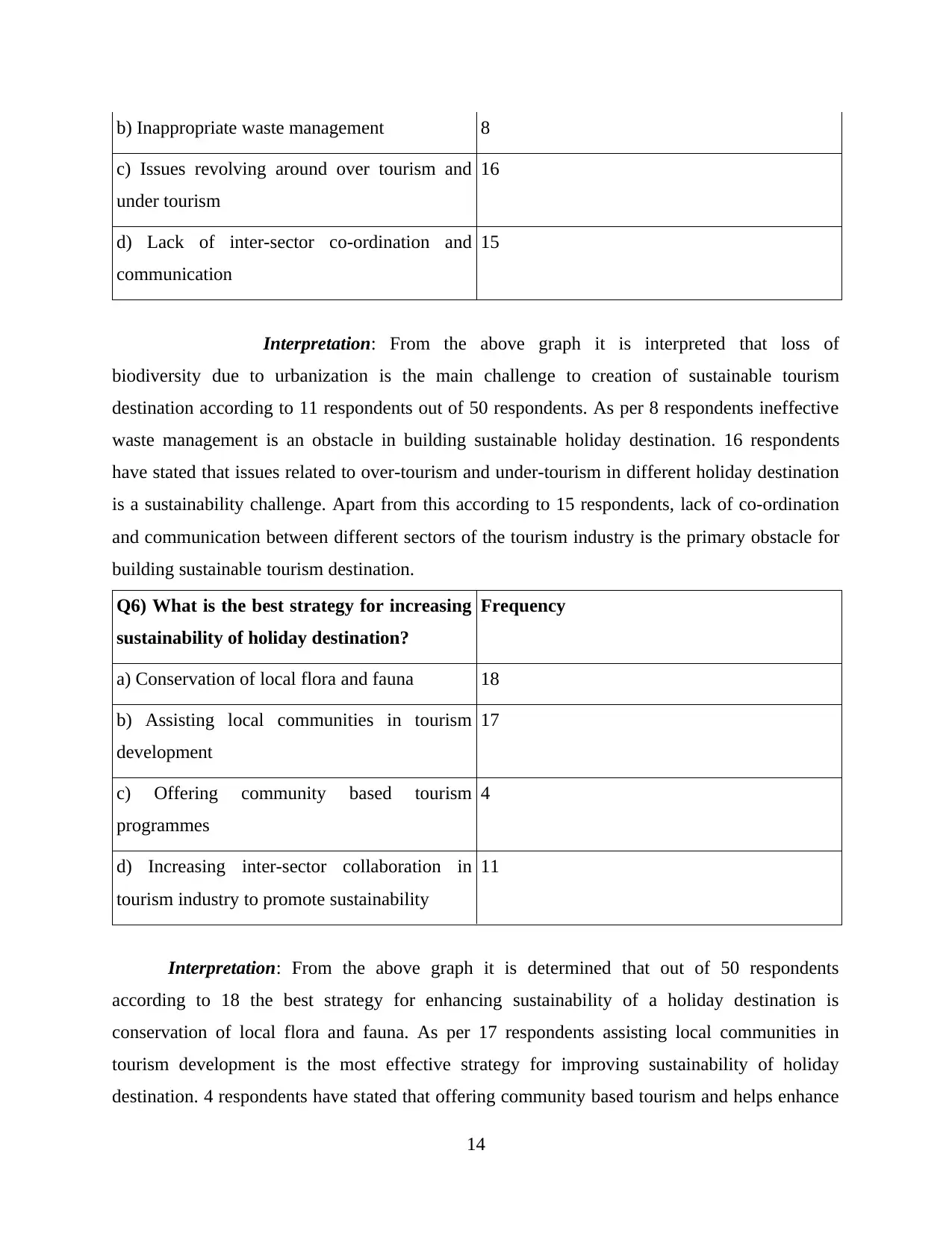
b) Inappropriate waste management 8
c) Issues revolving around over tourism and
under tourism
16
d) Lack of inter-sector co-ordination and
communication
15
Interpretation: From the above graph it is interpreted that loss of
biodiversity due to urbanization is the main challenge to creation of sustainable tourism
destination according to 11 respondents out of 50 respondents. As per 8 respondents ineffective
waste management is an obstacle in building sustainable holiday destination. 16 respondents
have stated that issues related to over-tourism and under-tourism in different holiday destination
is a sustainability challenge. Apart from this according to 15 respondents, lack of co-ordination
and communication between different sectors of the tourism industry is the primary obstacle for
building sustainable tourism destination.
Q6) What is the best strategy for increasing
sustainability of holiday destination?
Frequency
a) Conservation of local flora and fauna 18
b) Assisting local communities in tourism
development
17
c) Offering community based tourism
programmes
4
d) Increasing inter-sector collaboration in
tourism industry to promote sustainability
11
Interpretation: From the above graph it is determined that out of 50 respondents
according to 18 the best strategy for enhancing sustainability of a holiday destination is
conservation of local flora and fauna. As per 17 respondents assisting local communities in
tourism development is the most effective strategy for improving sustainability of holiday
destination. 4 respondents have stated that offering community based tourism and helps enhance
14
c) Issues revolving around over tourism and
under tourism
16
d) Lack of inter-sector co-ordination and
communication
15
Interpretation: From the above graph it is interpreted that loss of
biodiversity due to urbanization is the main challenge to creation of sustainable tourism
destination according to 11 respondents out of 50 respondents. As per 8 respondents ineffective
waste management is an obstacle in building sustainable holiday destination. 16 respondents
have stated that issues related to over-tourism and under-tourism in different holiday destination
is a sustainability challenge. Apart from this according to 15 respondents, lack of co-ordination
and communication between different sectors of the tourism industry is the primary obstacle for
building sustainable tourism destination.
Q6) What is the best strategy for increasing
sustainability of holiday destination?
Frequency
a) Conservation of local flora and fauna 18
b) Assisting local communities in tourism
development
17
c) Offering community based tourism
programmes
4
d) Increasing inter-sector collaboration in
tourism industry to promote sustainability
11
Interpretation: From the above graph it is determined that out of 50 respondents
according to 18 the best strategy for enhancing sustainability of a holiday destination is
conservation of local flora and fauna. As per 17 respondents assisting local communities in
tourism development is the most effective strategy for improving sustainability of holiday
destination. 4 respondents have stated that offering community based tourism and helps enhance
14
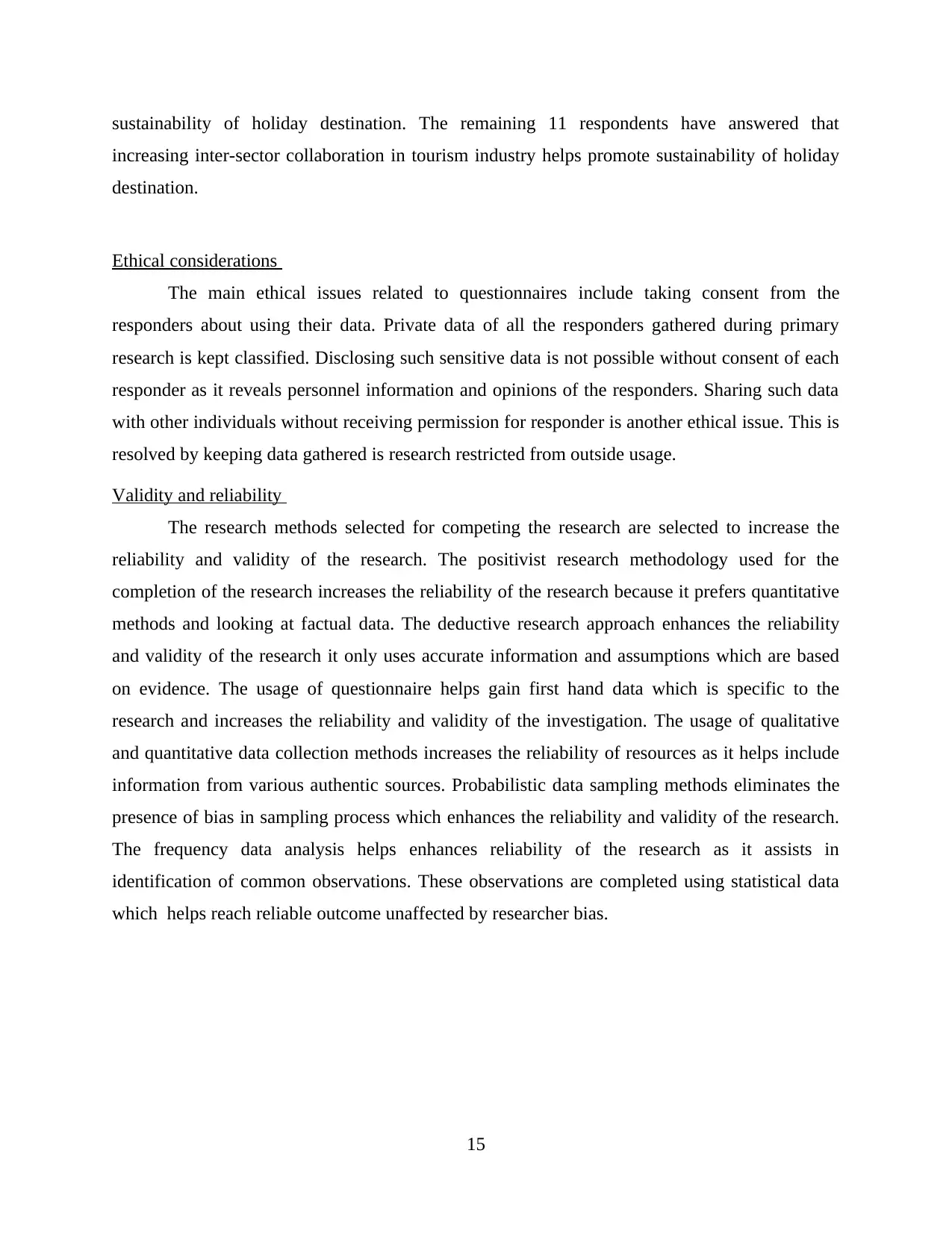
sustainability of holiday destination. The remaining 11 respondents have answered that
increasing inter-sector collaboration in tourism industry helps promote sustainability of holiday
destination.
Ethical considerations
The main ethical issues related to questionnaires include taking consent from the
responders about using their data. Private data of all the responders gathered during primary
research is kept classified. Disclosing such sensitive data is not possible without consent of each
responder as it reveals personnel information and opinions of the responders. Sharing such data
with other individuals without receiving permission for responder is another ethical issue. This is
resolved by keeping data gathered is research restricted from outside usage.
Validity and reliability
The research methods selected for competing the research are selected to increase the
reliability and validity of the research. The positivist research methodology used for the
completion of the research increases the reliability of the research because it prefers quantitative
methods and looking at factual data. The deductive research approach enhances the reliability
and validity of the research it only uses accurate information and assumptions which are based
on evidence. The usage of questionnaire helps gain first hand data which is specific to the
research and increases the reliability and validity of the investigation. The usage of qualitative
and quantitative data collection methods increases the reliability of resources as it helps include
information from various authentic sources. Probabilistic data sampling methods eliminates the
presence of bias in sampling process which enhances the reliability and validity of the research.
The frequency data analysis helps enhances reliability of the research as it assists in
identification of common observations. These observations are completed using statistical data
which helps reach reliable outcome unaffected by researcher bias.
15
increasing inter-sector collaboration in tourism industry helps promote sustainability of holiday
destination.
Ethical considerations
The main ethical issues related to questionnaires include taking consent from the
responders about using their data. Private data of all the responders gathered during primary
research is kept classified. Disclosing such sensitive data is not possible without consent of each
responder as it reveals personnel information and opinions of the responders. Sharing such data
with other individuals without receiving permission for responder is another ethical issue. This is
resolved by keeping data gathered is research restricted from outside usage.
Validity and reliability
The research methods selected for competing the research are selected to increase the
reliability and validity of the research. The positivist research methodology used for the
completion of the research increases the reliability of the research because it prefers quantitative
methods and looking at factual data. The deductive research approach enhances the reliability
and validity of the research it only uses accurate information and assumptions which are based
on evidence. The usage of questionnaire helps gain first hand data which is specific to the
research and increases the reliability and validity of the investigation. The usage of qualitative
and quantitative data collection methods increases the reliability of resources as it helps include
information from various authentic sources. Probabilistic data sampling methods eliminates the
presence of bias in sampling process which enhances the reliability and validity of the research.
The frequency data analysis helps enhances reliability of the research as it assists in
identification of common observations. These observations are completed using statistical data
which helps reach reliable outcome unaffected by researcher bias.
15
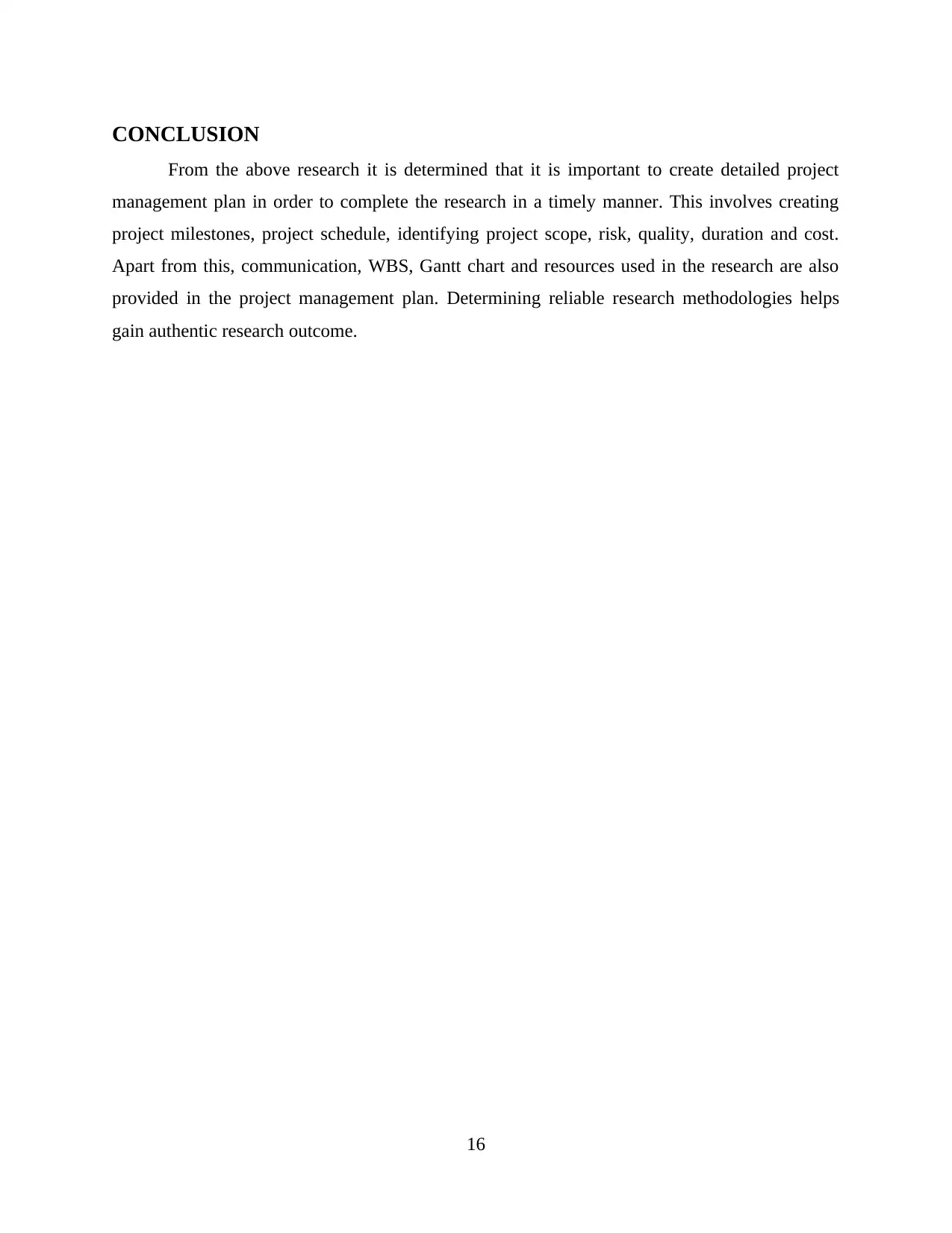
CONCLUSION
From the above research it is determined that it is important to create detailed project
management plan in order to complete the research in a timely manner. This involves creating
project milestones, project schedule, identifying project scope, risk, quality, duration and cost.
Apart from this, communication, WBS, Gantt chart and resources used in the research are also
provided in the project management plan. Determining reliable research methodologies helps
gain authentic research outcome.
16
From the above research it is determined that it is important to create detailed project
management plan in order to complete the research in a timely manner. This involves creating
project milestones, project schedule, identifying project scope, risk, quality, duration and cost.
Apart from this, communication, WBS, Gantt chart and resources used in the research are also
provided in the project management plan. Determining reliable research methodologies helps
gain authentic research outcome.
16
Secure Best Marks with AI Grader
Need help grading? Try our AI Grader for instant feedback on your assignments.
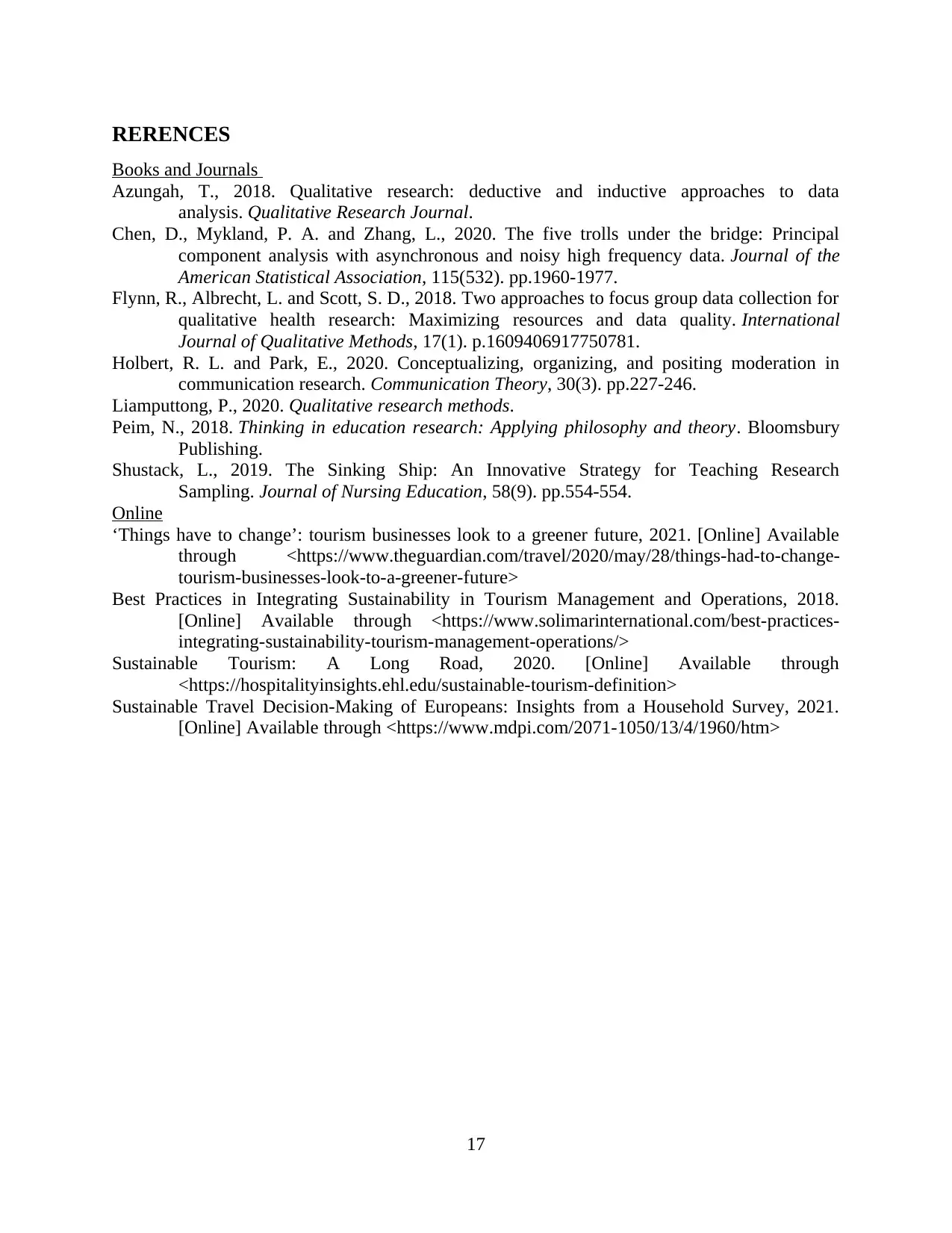
RERENCES
Books and Journals
Azungah, T., 2018. Qualitative research: deductive and inductive approaches to data
analysis. Qualitative Research Journal.
Chen, D., Mykland, P. A. and Zhang, L., 2020. The five trolls under the bridge: Principal
component analysis with asynchronous and noisy high frequency data. Journal of the
American Statistical Association, 115(532). pp.1960-1977.
Flynn, R., Albrecht, L. and Scott, S. D., 2018. Two approaches to focus group data collection for
qualitative health research: Maximizing resources and data quality. International
Journal of Qualitative Methods, 17(1). p.1609406917750781.
Holbert, R. L. and Park, E., 2020. Conceptualizing, organizing, and positing moderation in
communication research. Communication Theory, 30(3). pp.227-246.
Liamputtong, P., 2020. Qualitative research methods.
Peim, N., 2018. Thinking in education research: Applying philosophy and theory. Bloomsbury
Publishing.
Shustack, L., 2019. The Sinking Ship: An Innovative Strategy for Teaching Research
Sampling. Journal of Nursing Education, 58(9). pp.554-554.
Online
‘Things have to change’: tourism businesses look to a greener future, 2021. [Online] Available
through <https://www.theguardian.com/travel/2020/may/28/things-had-to-change-
tourism-businesses-look-to-a-greener-future>
Best Practices in Integrating Sustainability in Tourism Management and Operations, 2018.
[Online] Available through <https://www.solimarinternational.com/best-practices-
integrating-sustainability-tourism-management-operations/>
Sustainable Tourism: A Long Road, 2020. [Online] Available through
<https://hospitalityinsights.ehl.edu/sustainable-tourism-definition>
Sustainable Travel Decision-Making of Europeans: Insights from a Household Survey, 2021.
[Online] Available through <https://www.mdpi.com/2071-1050/13/4/1960/htm>
17
Books and Journals
Azungah, T., 2018. Qualitative research: deductive and inductive approaches to data
analysis. Qualitative Research Journal.
Chen, D., Mykland, P. A. and Zhang, L., 2020. The five trolls under the bridge: Principal
component analysis with asynchronous and noisy high frequency data. Journal of the
American Statistical Association, 115(532). pp.1960-1977.
Flynn, R., Albrecht, L. and Scott, S. D., 2018. Two approaches to focus group data collection for
qualitative health research: Maximizing resources and data quality. International
Journal of Qualitative Methods, 17(1). p.1609406917750781.
Holbert, R. L. and Park, E., 2020. Conceptualizing, organizing, and positing moderation in
communication research. Communication Theory, 30(3). pp.227-246.
Liamputtong, P., 2020. Qualitative research methods.
Peim, N., 2018. Thinking in education research: Applying philosophy and theory. Bloomsbury
Publishing.
Shustack, L., 2019. The Sinking Ship: An Innovative Strategy for Teaching Research
Sampling. Journal of Nursing Education, 58(9). pp.554-554.
Online
‘Things have to change’: tourism businesses look to a greener future, 2021. [Online] Available
through <https://www.theguardian.com/travel/2020/may/28/things-had-to-change-
tourism-businesses-look-to-a-greener-future>
Best Practices in Integrating Sustainability in Tourism Management and Operations, 2018.
[Online] Available through <https://www.solimarinternational.com/best-practices-
integrating-sustainability-tourism-management-operations/>
Sustainable Tourism: A Long Road, 2020. [Online] Available through
<https://hospitalityinsights.ehl.edu/sustainable-tourism-definition>
Sustainable Travel Decision-Making of Europeans: Insights from a Household Survey, 2021.
[Online] Available through <https://www.mdpi.com/2071-1050/13/4/1960/htm>
17
1 out of 17
Related Documents
Your All-in-One AI-Powered Toolkit for Academic Success.
+13062052269
info@desklib.com
Available 24*7 on WhatsApp / Email
![[object Object]](/_next/static/media/star-bottom.7253800d.svg)
Unlock your academic potential
© 2024 | Zucol Services PVT LTD | All rights reserved.




